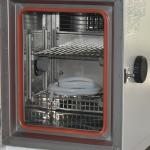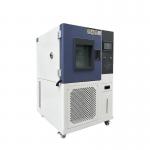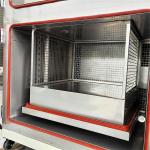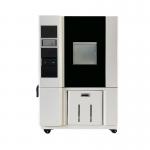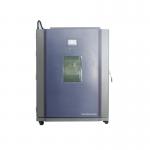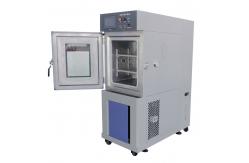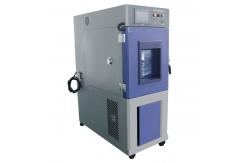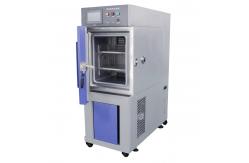In the fast-paced and highly competitive electronics industry, the
reliability and durability of products are non-negotiable. Constant
Climate Chambers and Temperature Humidity Test Chambers emerge as
essential tools, specifically designed to meet the unique and
stringent requirements of this sector. These specialized chambers are engineered to expose electronic
components, devices, and systems to a comprehensive range of
extreme and controlled temperature and humidity conditions. They
play a crucial role in electronics manufacturing, research and
development, and quality control. By replicating the diverse and
often harsh environmental scenarios that electronics may encounter
during their lifecycle, from the thin air and temperature
fluctuations of high-altitude flights to the humid and hot
conditions in tropical regions or industrial settings, they enable
manufacturers and engineers to assess the performance,
functionality, and integrity of their products. This is essential
for identifying potential weaknesses and making informed design and
manufacturing improvements, ensuring that electronic devices can
operate flawlessly and withstand the rigors of real-world
applications. - Durable and Insulated Chamber Design
- The testing chamber is constructed with high-strength,
corrosion-resistant materials to endure the stresses of continuous
temperature and humidity cycling. The walls are composed of
multiple layers of advanced insulation, providing exceptional
thermal and moisture isolation. This insulation not only guarantees
precise temperature and humidity control but also safeguards
against external environmental interference, maintaining a stable
and consistent testing environment. The interior surface is smooth
and non-conductive, preventing any electrostatic discharge or
chemical reactions that could damage the sensitive electronic
samples.
- The chamber door is equipped with a high-precision sealing
mechanism, ensuring airtightness even under significant temperature
and humidity differentials. It is engineered for effortless
operation, allowing for convenient loading and unloading of various
electronic components and assemblies. The overall structure is
built to withstand the mechanical forces associated with rapid
temperature and humidity changes, safeguarding the integrity of the
equipment and the samples within.
- Advanced Temperature and Humidity Control Systems
- The temperature control system is a marvel of modern engineering,
capable of achieving an extensive temperature range. It can plummet
to as low as -70°C, simulating the frigid conditions of polar
regions or high-altitude environments, and soar up to +150°C,
replicating the heat generated in confined electronic enclosures or
desert-like operating conditions. The temperature can be adjusted
with an accuracy of ±0.3°C, enabling precise and repeatable
testing.
- The humidity control system is equally sophisticated. It can create
a wide range of humidity conditions, from bone-dry levels as low as
5% relative humidity to highly humid environments up to 95%
relative humidity. The humidity control precision is within ±2%
relative humidity, ensuring accurate and reliable testing
scenarios. The system also offers programmable humidity profiles,
allowing for the simulation of complex environmental changes, such
as the rapid increase in humidity during a rainstorm or the drying
effect of a desert wind.
- Precision Instrumentation and Data Acquisition
- The equipment is outfitted with a suite of state-of-the-art
sensors. Temperature sensors are strategically positioned
throughout the chamber to monitor any temperature gradients and
ensure uniform thermal exposure. Humidity sensors provide real-time
data on the internal humidity levels, while additional sensors can
be incorporated to measure other parameters such as dew point or
air pressure, depending on the specific testing requirements. These
sensors are connected to a cutting-edge data acquisition system
that records and stores all the measured variables in real-time.
The data can be accessed and analyzed instantly or retrieved later
for in-depth studies and compliance reporting.
- The control panel of the equipment is intuitively designed,
enabling operators to effortlessly program and execute complex test
sequences. It allows for the precise setting of temperature,
humidity, and other parameters, as well as the customization of
test durations and cycling patterns. The panel displays all the
essential information, including current temperature, humidity, and
the status of the control systems, and features built-in alarms and
safety mechanisms to alert operators in case of any abnormal
conditions or system malfunctions.
| Model | JTC-80 | JTC-150 | JTC-225 | JTC-408 | JTC-800 | JTC-1000 | | Inside dimension(W x D x H) mm | 40 x 50 x40 | 50 x 60 x 50 | 50 x 75 x 60 | 60 x 85 x 80 | 100 x 100 x 80 | 100 x 100 x 100 | | Outside dimension(W x D x H) mm | 95 x 140 x 95 | 105 x 150 x 105 | 105 x 165 x 115 | 115 x 175 x 140 | 155 x 190 x 140 | 155 x 190 x 160 | | Internal material | #304 Stainless Steel | | External material | Powder coated #304 Stainless Steel | | Temperature range | + 150℃~ - 70 ℃ | | Humidity range | 10% ~ 98% R. H | | Temperature Uniformity ℃ | 0.01 | | Humidity Uniformity % R. H. | 0.1 | | Temperature stability ℃ | ±0.3 | | Humidity stability % R. H. | ±2 | | High temperature ℃ | 100 | 100 | 100 | 100 | 100 | 100 | | Heating time (min) | 20 | 30 | 30 | 30 | 30 | 30 | | Low temperature | 0, -40, -70 | 0, -40, -70 | 0, -40, -70 | 0, -40, -70 | 0, -40, -70 | 0, -40, -70 | | Cooling time (min) | 20, 50, 70 | 20, 50, 70 | 20, 50, 70 | 20, 50, 70 | 20, 50, 70 | 20, 50, 70 | | Air circulation system | Mechanical convection system | | Cooling system | Imported compressor, fin evaporator, gas condenser | | Heating system | Sus304 Stainless steel High-speed heater | | Humidification system | Steam Generator | | Humidification water supply | Reservoir, Sensor-controller solenoid valve, recovery-recycle
system | | Controller | Touch panel | | Electrical power requirements | Please contact us for requirements of specific models | | Accessories | Multi-layer enhanced glass window,test hole, action indicator
light, case lighting barrier shelf x2 | | Safety device | Circuit system load protection, compressor load protection, control
system load protection, humidifier load protection, overtemperature
load protection, fault warning light |
- Accurate Environmental Replication for Electronic Devices
- The primary function of these chambers is to faithfully reproduce
the complex and demanding environmental conditions that electronic
products face. By precisely controlling temperature and humidity,
it allows manufacturers to evaluate how their products will behave
in various real-world situations. For instance, testing a
smartphone's display under high-altitude low-humidity and cold
temperature conditions can reveal any issues with image quality,
touch responsiveness, or even structural integrity. This
information can then be used to optimize the display design, select
more suitable materials, or improve the device's thermal and
humidity management systems, enhancing its overall reliability and
user experience.
- The ability to conduct cyclic temperature and humidity tests is a
powerful feature. This involves subjecting electronic samples to
repeated and alternating temperature and humidity changes, which
can uncover latent defects or weaknesses that might not be apparent
under static conditions. For example, a printed circuit board may
appear to function normally at a single temperature and humidity
but develop cracks or solder joint failures after several cycles of
extreme temperature and humidity variation. The testing chambers
can detect such issues early in the product development cycle,
enabling manufacturers to make corrective actions and avoid costly
recalls or field failures.
- Ensuring Compliance with Electronics Industry Standards
- The electronics industry is governed by a multitude of strict
standards and regulations regarding product quality and
environmental testing. These Constant Climate Chambers and
Temperature Humidity Test Chambers are reliable tools for ensuring
compliance. For example, many electronic components and devices
need to meet specific temperature and humidity performance
requirements set by organizations like the International
Electrotechnical Commission (IEC) or industry-specific
associations. By using these chambers to conduct tests in
accordance with these standards, manufacturers can prove that their
products are fit for purpose and gain market access.
- Regulatory bodies rely on accurate test results obtained from such
chambers to enforce safety and quality regulations. It serves as a
means for inspectors to determine whether electronic products can
withstand the environmental stresses they may encounter during
their intended use, thereby protecting consumers and maintaining
the integrity of the electronics market.
- Driving Innovation in Electronics Research and Development
|
